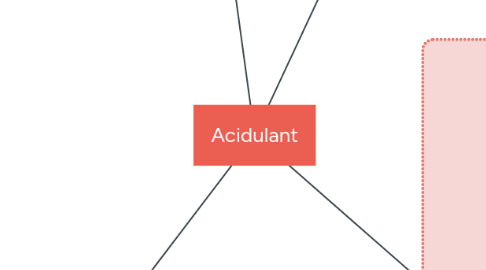
1. Application
1.1. Food preservation and processing
1.2. Condiments
1.3. Fruit preserve
1.4. Savoury
1.4.1. As shelf life regulator
1.4.2. Improve processing efficiency
1.4.3. Stabilize quality of fermented meat and cheese product
1.5. Bakery and desserts
1.6. Beverages
1.6.1. Citric
1.6.1.1. Slightly sharp sourness and refreshing effect on most of fruit flavors
1.6.2. Malic
1.6.2.1. Fruit flavor in combination with citric acid
1.6.3. Phosphoric
1.6.3.1. Cola
1.7. Confections
1.7.1. Malic
1.7.1.1. Enhance fruit flavors and boost the impact of high intense sweeteners
1.7.2. Fumaric
1.7.2.1. Provide more persistent sourness than other food acids at same concentration
2. Tpes of acid
2.1. Organic acid
2.1.1. Carboxylic acid
2.1.1.1. Monocarboxylic acid
2.1.1.1.1. Acetic acid
2.1.1.1.2. Propionic acid
2.1.1.1.3. Lactic acid
2.1.1.1.4. Gluconic acid
2.1.1.2. Dicarboxylic acid
2.1.1.2.1. Malic acid
2.1.1.2.2. Fumaric acid
2.1.1.2.3. Tartaric acid
2.1.1.2.4. Adipic acid
2.1.1.2.5. Succinic acid
2.1.1.3. Tricarboxylic acid
2.1.1.3.1. Citric acid
2.1.2. Phenolic acid
2.1.2.1. Benzoic acid
2.1.3. Fatty acid
2.1.3.1. Sorbic acid
2.1.3.2. Caprylic acid
2.1.3.3. Butyric acid
2.1.4. Lactones
2.1.4.1. Ascorbic acid
2.1.4.2. Gluconolactone
2.1.5. Amino acid
2.1.5.1. Lysine
2.1.5.2. Cysteine
2.1.5.3. Glutamic acid
2.2. Inorganic acid
2.2.1. Phosphoric acid
2.2.2. Hydrochloric acid
2.2.3. Sulphuric acid
3. Common acidulants
4. Function
4.1. Chelating agents
4.1.1. Eg: Citric, malic, lactic, tartaric acid
4.2. Gelling and coagulating agents
4.2.1. For gelling high methoxyl pectin, the pH must be adjusted to 2.5 to 3.5.
4.3. Leavening
4.4. Oxidation and reduction
4.4.1. citric acid in candies (lime, orange ) ----cheapest
4.5. Enhance flavour
4.5.1. phosphoric acid in coke
4.5.2. Malic acid (fruit flavour)
4.5.3. Tartaric acid (Grape)
4.5.4. Acetic acid (vinegar)
4.6. pH control
4.6.1. Tartaric acid can only be used for buffering between pH 3.0 and 4.5.
4.6.2. Citric acid has the widest effective buffer range -- from pH 2.5 to 6.5.
4.7. Preservatives
4.7.1. Sorbic acid
4.7.2. propionic acid in baking
4.7.3. Benzoic acid
5. Definition
5.1. Substances (organic or inorganic) which release hydrogen and a salt part in water solution.
5.1.1. H+ ion increases, acidity increases, pH decreases

